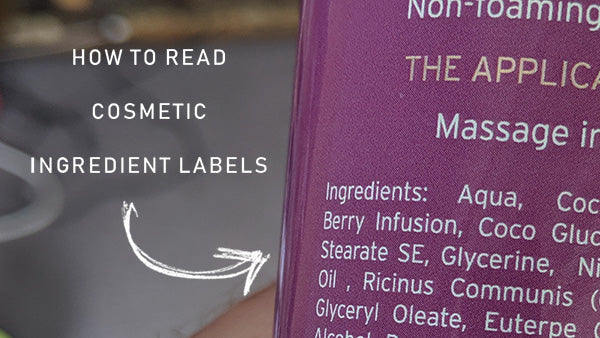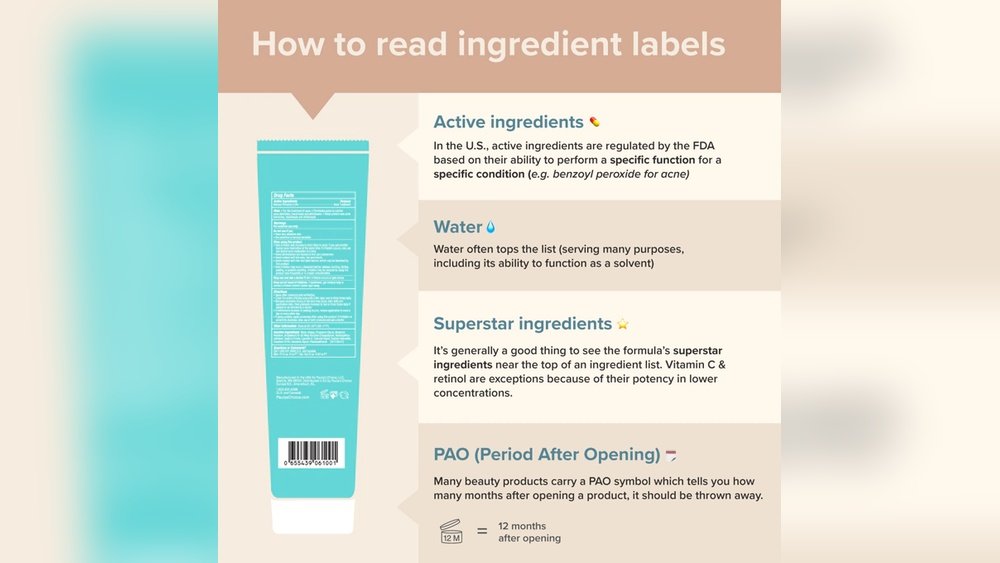Have you ever stared at a cosmetic product’s ingredient list and felt completely lost? You’re not alone.
Those long, complicated names can be confusing, making it hard to know what you’re really putting on your skin. But what if you could quickly spot which ingredients benefit you and which to avoid? Understanding how to read a cosmetic ingredient list puts the power back in your hands, helping you choose products that truly work for your skin type and goals.
Keep reading, and you’ll learn simple, effective tips to decode those labels like a pro—no science degree required. Your skin will thank you!

Credit: us.upcirclebeauty.com
Ingredient Order Basics
Understanding the basics of ingredient order helps you see what a cosmetic product contains. The ingredient list shows all components used in making the product. These ingredients appear in a specific order that reveals their amount.
Knowing how to read this order can guide your choices. It tells you which ingredients are most common in the product. It also helps spot ingredients you may want to avoid or seek.
Descending Quantity Listing
Ingredients are listed by weight from highest to lowest. The first ingredient is the one present in the largest amount. Each next ingredient follows in smaller quantities. This order gives an idea of the product’s main contents.
For example, if water is first, the product mainly contains water. If a certain oil is second, it is the next most used ingredient. This helps understand the product’s formula and its effects on skin.
Exceptions To The Rule
Some ingredients appear at the end, even if used in larger amounts. Ingredients under 1% can be listed in any order. Fragrances and color additives often come last regardless of quantity. This is a legal requirement.
Keep in mind, the order may not fully show the exact amount of each ingredient. But it still helps to compare similar products. Always look closely at the full list for best knowledge.
Common Cosmetic Ingredients
Common cosmetic ingredients appear on every product label. They include substances that make the product work and those that keep it safe and pleasant. Knowing these ingredients helps you choose products that suit your skin type. It also helps avoid unwanted reactions.
Many ingredients have specific roles. Some treat skin problems or improve skin health. Others fill space, preserve the product, or add fragrance. Recognizing these can improve your shopping decisions.
Active Ingredients To Watch
Active ingredients provide the main benefit of the product. They target issues like acne, wrinkles, or dryness. Examples include salicylic acid for acne and hyaluronic acid for hydration. Retinol helps reduce fine lines and boosts skin renewal.
Some actives may cause irritation or sensitivity. Patch testing new products is a smart step. Check the concentration of actives to avoid overuse. These ingredients are usually listed near the top of the label.
Common Fillers And Preservatives
Fillers add texture and volume to cosmetics. Ingredients like water, glycerin, and dimethicone smooth the skin and spread easily. They do not have direct treatment effects but improve product feel.
Preservatives keep products fresh and safe from bacteria. Common ones include parabens, phenoxyethanol, and benzyl alcohol. Preservatives prevent spoilage but may cause allergies in some people.
Understanding fillers and preservatives helps identify potential irritants. This knowledge supports safer and better choices for your skin health.
Decoding Ingredient Names
Understanding the ingredient names on cosmetic labels helps you choose better products. These names often look complex or strange. They follow specific rules for naming. Learning how to decode them makes shopping easier and safer.
Inci Names Explained
INCI stands for International Nomenclature of Cosmetic Ingredients. It is a system used worldwide to name cosmetic ingredients. Each ingredient has one official INCI name. This name is usually in Latin or English.
The INCI name tells you the exact substance in the product. For example, “Aqua” means water. “Butyrospermum Parkii Butter” means shea butter. This system keeps ingredient names consistent everywhere.
INCI names may look long or scientific. This is because they describe the chemical or plant source clearly. Brands cannot change these names. They must list ingredients using the official INCI terms.
Natural Vs Synthetic Labels
Ingredients can be natural or synthetic. Natural ingredients come from plants, minerals, or animals. Synthetic ingredients are made in labs. Both types can be safe and effective.
Natural labels often list plant oils, extracts, or waxes. Examples include “Lavandula Angustifolia Oil” (lavender oil) or “Cera Alba” (beeswax). These names come from nature but may still seem complex.
Synthetic ingredients have names like “Dimethicone” or “Phenoxyethanol.” They are made to improve texture, preservation, or performance. They help keep the product stable and safe to use.
Not all natural ingredients suit everyone. Some may cause allergies. Synthetic ingredients are tested for safety. Reading the list helps you spot ingredients you want or want to avoid.
Identifying Potential Irritants
Identifying potential irritants in cosmetic products helps protect your skin. Knowing which ingredients may cause reactions is important. Some substances trigger allergies or sensitivities. Others contain harmful chemicals that can damage your skin over time.
Understanding these ingredients lets you choose safer products. It also helps avoid discomfort and long-term skin problems. Focus on reading labels carefully to spot these irritants early.
Allergens And Sensitizers
Allergens cause allergic reactions in some people. Sensitizers may cause skin sensitivity after repeated use. Common allergens include fragrances, preservatives, and certain plant extracts.
Fragrance is often listed as “parfum” or “aroma.” It can cause redness, itching, or rashes. Preservatives like parabens, formaldehyde releasers, and methylisothiazolinone also cause reactions.
Look for ingredients such as limonene, linalool, and cinnamal. They are natural fragrance components that may irritate sensitive skin. Avoid products with these if your skin reacts easily.
How To Spot Harmful Chemicals
Some chemicals harm the skin or overall health. Avoid harsh sulfates like sodium lauryl sulfate (SLS). They strip natural oils and cause dryness.
Check for parabens, which act as preservatives but may disrupt hormones. Avoid ingredients like phthalates, often hidden in fragrance blends. They link to health concerns.
Be cautious of formaldehyde and its releasers. These preservatives may cause allergic reactions and irritation. Also, steer clear of synthetic dyes and heavy alcohols that dry out skin.
Tips For Smart Label Reading
Reading cosmetic ingredient lists can seem confusing at first. Smart label reading helps you make better choices. It allows you to avoid harmful chemicals and pick products that suit your skin. This section shares practical tips for reading labels with confidence.
Understanding ingredients boosts your skincare knowledge. It helps protect your skin and wallet. Let’s explore simple ways to read and understand cosmetic labels effectively.
Using Ingredient Decoding Tools
Ingredient decoding tools simplify complex names on labels. They explain what each ingredient does and if it is safe. Many websites and apps offer free ingredient checkers. Just enter the ingredient name to get clear information.
These tools highlight allergens, irritants, and beneficial ingredients. They help you avoid harmful substances like parabens or sulfates. Use decoding tools to compare products and pick the best one.
Keep a list of common ingredients you want to avoid. Check new products against this list with the tools. This step saves time and prevents skin problems.
Choosing Products For Your Skin Type
Not all ingredients suit every skin type. Knowing your skin type is key to choosing products wisely. For dry skin, look for moisturizing ingredients like glycerin and hyaluronic acid. Oily skin benefits from lightweight, non-comedogenic formulas.
Sensitive skin needs gentle ingredients such as aloe vera or chamomile. Avoid fragrances and alcohol in sensitive skin products. Combination skin may need a mix of both hydrating and oil-controlling ingredients.
Reading labels helps find products that match your skin needs. This reduces breakouts, irritation, or dryness. Always choose products with ingredients that support your skin health.

Credit: uxbskincare.com

Credit: wishtrend.com
Frequently Asked Questions
How To Read A Cosmetic Ingredient List?
Read cosmetic ingredient lists by noting ingredients from highest to lowest concentration. Focus on key actives near the top. Avoid products with long, complex lists. Understand common ingredient names and their functions. This helps identify beneficial or harmful components quickly and effectively.
How Do You Read The Ingredients List?
Read the ingredients list from highest to lowest quantity. Focus on the first few ingredients for main components. Avoid products with long, complex ingredient lists. Look for recognizable, whole-food ingredients and key actives. This helps identify product quality and potential allergens quickly.
What Is The 1% Rule In Skincare?
The 1% rule in skincare means active ingredients must be at least 1% concentration to be effective. Below that, benefits are minimal.
What Is The Hierarchy Of Ingredients?
The hierarchy of ingredients lists components from highest to lowest concentration by weight. The first ingredients appear in the greatest amounts. This order helps identify key active and inactive substances in a product. Understanding this hierarchy guides informed choices in skincare and cosmetics.
What Is The Order Of Ingredients On A Cosmetic List?
Ingredients are listed from highest to lowest amount used in the product.
How Can I Identify Harmful Ingredients Quickly?
Look for known irritants like parabens, sulfates, and synthetic fragrances early in the list.
Why Are Some Ingredients Listed With Complex Names?
They use scientific or INCI names to standardize ingredient labeling worldwide.
Conclusion
Reading cosmetic ingredient lists becomes easier with practice and patience. Focus on the top ingredients, as they make up most of the product. Avoid products with long, complicated ingredient lists you cannot understand. Knowing common ingredient names helps you spot harmful or beneficial components.
Always check for allergens if you have sensitive skin. This skill protects your skin and helps you choose better products. Keep learning and stay curious about what you put on your skin. Small steps lead to smarter, safer skincare choices every day.
 Skip to content
Skip to content 